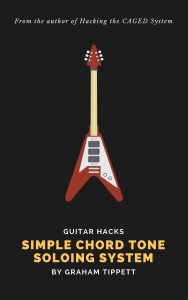
Chord tone soloing and soloing over changes on guitar is a complex area which can be approached in many ways, and where even a cursory search for online resources is likely to leave you with more questions than answers. That’s why we’ve come up with this simple chord tone soloing course to help you get into tricky but worthwhile part of guitar playing and music itself.
Chord tone soloing particularly difficult on guitar because guitarists tend to arrive at this point with varying amounts of knowledge and gaps in their playing, whereas other instrumentalists approach soloing over changes in a more uniform way.
What’s in the Chord Tone Soloing Course?
While it’s true that everyone learns differently, I believe that a solid chord tone soloing course requires a system that is a) not based on patterns, b) develops the ability to locate notes on the neck either by interval or by the name of the note, and c) develops the player’s ear to the point where he/she is able to fully express themselves and truly improvise on their instrument as oppose to a formulaic, calculated and somewhat cold approach to something that should be, insofar as is possible, spontaneously created in the moment; and this is what I hope to achieve with this free chord tone soloing course.
If you don’t have one already, I’d recommend buying a looper pedal as it will speed up the process of learning to improvise over changes immensely. You can pick up a looper for as little as $50, and there’s a great selection on Amazon which you can check out here. My personal favorites are the TC Electronic Ditto and the Boss RC-1, although pretty much any looper pedal on the market is great value for money.